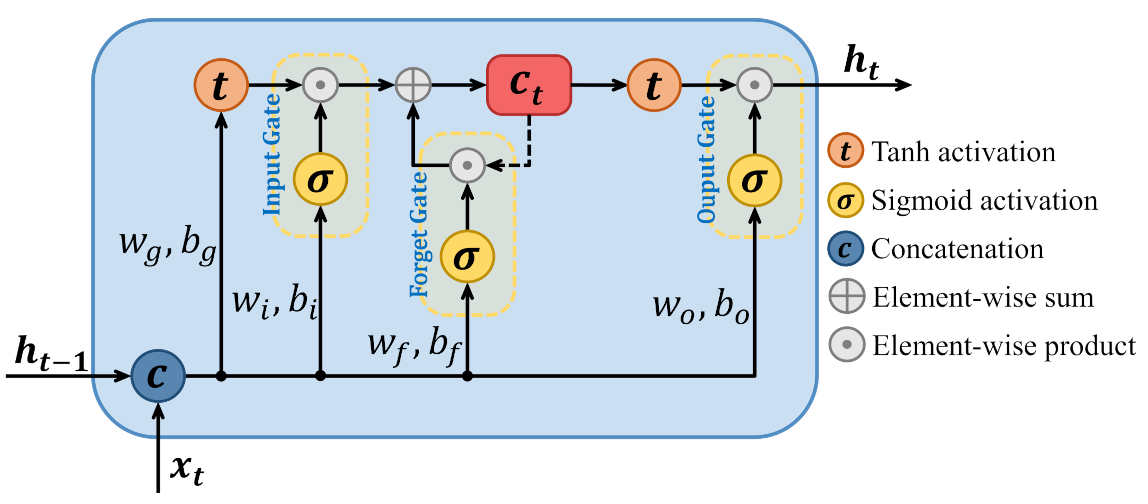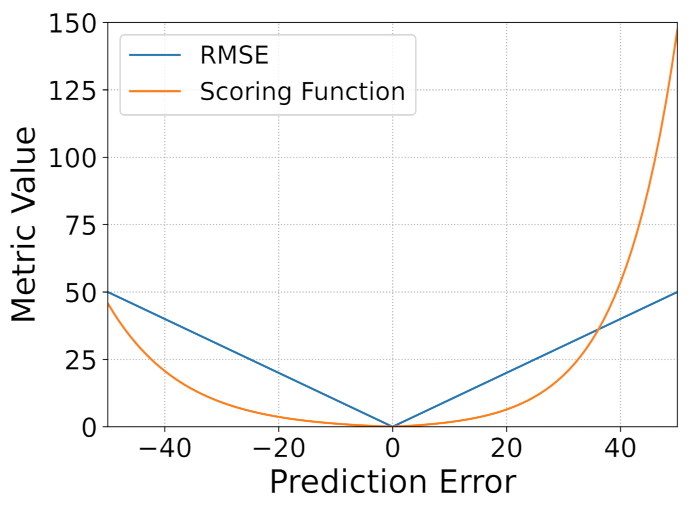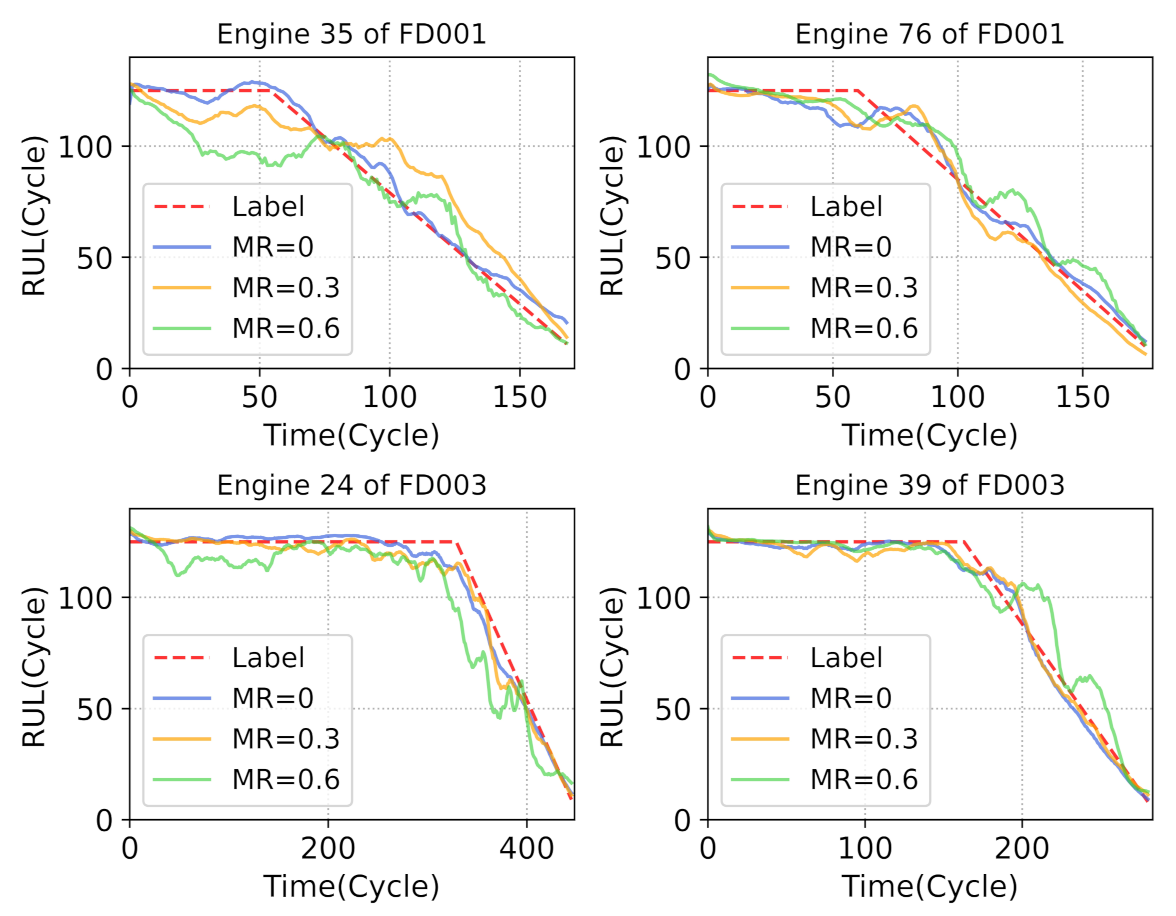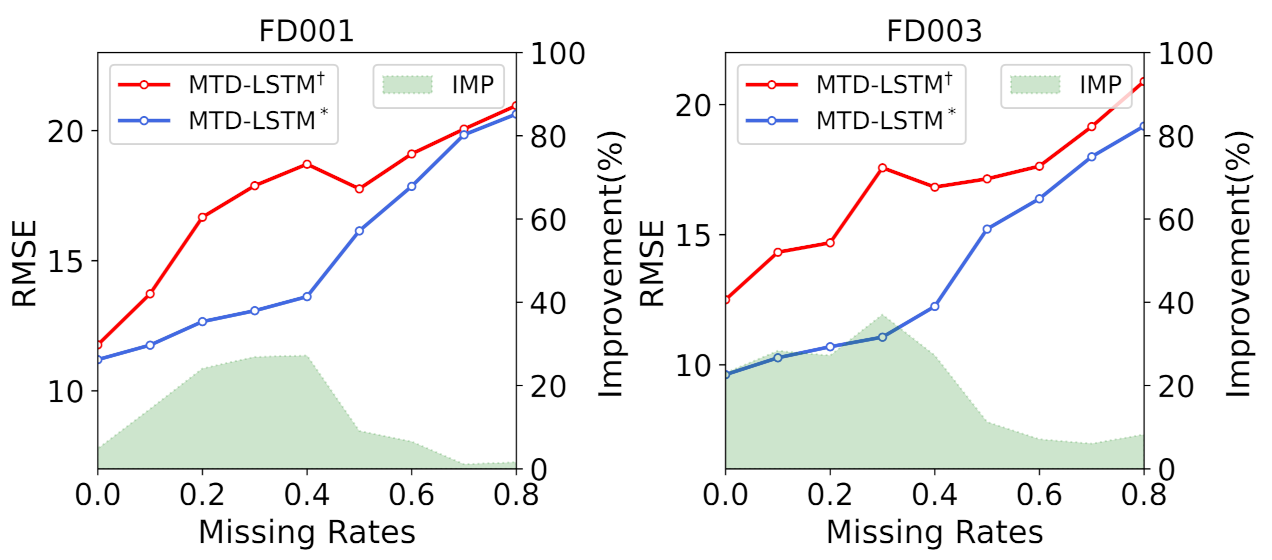LSTM-Based Multi-Task Method for Remaining Useful Life Prediction under Corrupted Sensor Data
Abstract
1. Introduction
- 1.
- A novel multi-task method is proposed for RUL prediction under corrupted sensor data. With the assistance of the missing values imputation module, the proposed method can perform well in RUL prediction under corrupted sensor data.
- 2.
- A novel loss term is introduced for improving the RUL prediction performance, which can smooth the predicted RUL without any manual post-processing.
- 3.
- Extensive comparative experiments and ablation studies verified the effectiveness of the proposed method.
2. Methodology
2.1. Problem Statement
2.2. Overview
2.3. Feature Extraction and Fusion Module
2.4. Multi-Task Learning
2.5. Monotone and Linearly Decreasing Loss
3. Experimental Study
3.1. Dataset Description
3.2. Evaluation Metrics
3.3. Data Preprocessing
3.3.1. Normalization
3.3.2. Corrupted Sensor Data Simulation
3.3.3. Sliding Window Processing and Label Construction
3.4. Experimental Settings and Results
3.4.1. Experimental Settings
3.4.2. Effectiveness of the Proposed Method
3.4.3. Ablation Study
3.4.4. Comparisons with Other Methods
4. Conclusions
Author Contributions
Funding
Institutional Review Board Statement
Informed Consent Statement
Data Availability Statement
Conflicts of Interest
References
- Zhao, Z.; Liang, B.; Wang, X.; Lu, W. Remaining useful life prediction of aircraft engine based on degradation pattern learning. Reliab. Eng. Syst. Saf. 2017, 164, 74–83. [Google Scholar] [CrossRef]
- Lee, J.; Wu, F.; Zhao, W.; Ghaffari, M.; Liao, L.; Siegel, D. Prognostics and health management design for rotary machinery systems—Reviews, methodology and applications. Mech. Syst. Signal Process. 2014, 42, 314–334. [Google Scholar] [CrossRef]
- Pang, Z.; Xiaosheng, S.I.; Changhua, H.U.; Dangbo, D.U.; Pei, H. A Bayesian Inference for Remaining Useful Life Estimation by Fusing Accelerated Degradation Data and Condition Monitoring Data. Reliab. Eng. Syst. Saf. 2020, 208, 107341. [Google Scholar] [CrossRef]
- Cubillo, A.; Perinpanayagam, S.; Esperon-Miguez, M. A review of physics-based models in prognostics: Application to gears and bearings of rotating machinery. Adv. Mech. Eng. 2016, 8, 1687814016664660. [Google Scholar] [CrossRef]
- Zio, E.; Peloni, G. Particle filtering prognostic estimation of the remaining useful life of nonlinear components. Reliab. Eng. Syst. Saf. 2011, 96, 403–409. [Google Scholar] [CrossRef]
- Wang, Y.; Ni, Y.; Lu, S.; Wang, J.; Zhang, X. Remaining Useful Life Prediction of Lithium-Ion Batteries Using Support Vector Regression Optimized by Artificial Bee Colony. IEEE Trans. Veh. Technol. 2019, 68, 9543–9553. [Google Scholar] [CrossRef]
- Wei, J.; Dong, G.; Chen, Z. Remaining Useful Life Prediction and State of Health Diagnosis for Lithium-Ion Batteries Using Particle Filter and Support Vector Regression. IEEE Trans. Ind. Electron. 2018, 65, 5634–5643. [Google Scholar] [CrossRef]
- Liu, T.; Zhu, K. A Switching Hidden Semi-Markov Model for Degradation Process and Its Application to Time-Varying Tool Wear Monitoring. IEEE Trans. Ind. Inform. 2021, 17, 2621–2631. [Google Scholar] [CrossRef]
- Xiahou, T.; Zeng, Z.; Liu, Y. Remaining Useful Life Prediction by Fusing Experts’ Knowledge and Condition Monitoring Information. IEEE Trans. Ind. Inform. 2020, 17, 2653–2663. [Google Scholar] [CrossRef]
- Qin, Y.; Chen, D.; Xiang, S.; Zhu, C. Gated Dual Attention Unit Neural Networks for Remaining Useful Life Prediction of Rolling Bearings. IEEE Trans. Ind. Inform. 2021, 17, 6438–6447. [Google Scholar] [CrossRef]
- Wang, B.; Lei, Y.; Li, N.; Wang, W. Multiscale Convolutional Attention Network for Predicting Remaining Useful Life of Machinery. IEEE Trans. Ind. Electron. 2021, 68, 7496–7504. [Google Scholar] [CrossRef]
- Hochreiter, S.; Schmidhuber, J. Long Short-Term Memory. Neural Comput. 1997, 9, 1735–1780. [Google Scholar] [CrossRef]
- Arslan, R.S.; Bar, N. Development of Output Correction Methodology for Long Short Term Memory-Based Speech Recognition. Sustainability 2019, 11, 4250. [Google Scholar] [CrossRef]
- Lippi, M.; Montemurro, M.A.; Degli Esposti, M.; Cristadoro, G. Natural Language Statistical Features of LSTM-Generated Texts. IEEE Trans. Neural Netw. Learn. Syst. 2019, 30, 3326–3337. [Google Scholar] [CrossRef] [PubMed]
- Shuai, Z.; Ristovski, K.; Farahat, A.; Gupta, C. Long Short-Term Memory Network for Remaining Useful Life estimation. In Proceedings of the 2017 IEEE International Conference on Prognostics and Health Management (ICPHM), Santa Clara, CA, USA, 19–21 June 2017. [Google Scholar]
- Ren, L.; Dong, J.; Wang, X.; Meng, Z.; Zhao, L.; Deen, M.J. A Data-Driven Auto-CNN-LSTM Prediction Model for Lithium-Ion Battery Remaining Useful Life. IEEE Trans. Ind. Inform. 2021, 17, 3478–3487. [Google Scholar] [CrossRef]
- Song, T.; Liu, C.; Jiang, D. A Novel Framework for Machine Remaining Useful Life Prediction Based on Time Series Analysis. In Proceedings of the 2019 Prognostics and System Health Management Conference (PHM-Qingdao), Qingdao, China, 25–27 October 2019. [Google Scholar]
- Jw, A.; Kh, A.; Yc, B.; Hz, B.; Xs, B.; Yw, C. Data-driven remaining useful life prediction via multiple sensor signals and deep long short-term memory neural network. ISA Trans. 2020, 97, 241–250. [Google Scholar]
- Shah, S.R.B.; Chadha, G.S.; Schwung, A.; Ding, S.X. A Sequence-to-Sequence Approach for Remaining Useful Lifetime Estimation Using Attention-augmented Bidirectional LSTM. Intell. Syst. Appl. 2021, 10, 200049. [Google Scholar] [CrossRef]
- Huang, C.G.; Huang, H.Z.; Li, Y.F. A bidirectional LSTM prognostics method under multiple operational conditions. IEEE Trans. Ind. Electron. 2019, 66, 8792–8802. [Google Scholar] [CrossRef]
- Miao, H.; Li, B.; Sun, C.; Liu, J. Joint learning of degradation assessment and RUL prediction for aeroengines via dual-task deep LSTM networks. IEEE Trans. Ind. Inform. 2019, 15, 5023–5032. [Google Scholar] [CrossRef]
- Ma, M.; Mao, Z. Deep-Convolution-Based LSTM Network for Remaining Useful Life Prediction. IEEE Trans. Ind. Inform. 2021, 17, 1658–1667. [Google Scholar] [CrossRef]
- Saxena, A.; Goebel, K.; Simon, D.; Eklund, N. Damage propagation modeling for aircraft engine run-to-failure simulation. In Proceedings of the 2008 International Conference on Prognostics and Health Management, Denver, CO, USA, 6–9 October 2008; pp. 1–9. [Google Scholar] [CrossRef]
- Chen, Z.; Wu, M.; Zhao, R.; Guretno, F.; Yan, R.; Li, X. Machine Remaining Useful Life Prediction via an Attention-Based Deep Learning Approach. IEEE Trans. Ind. Electron. 2021, 68, 2521–2531. [Google Scholar] [CrossRef]
- Liu, H.; Liu, Z.; Jia, W.; Lin, X. Remaining Useful Life Prediction Using a Novel Feature-Attention-Based End-to-End Approach. IEEE Trans. Ind. Inform. 2020, 17, 1197–1207. [Google Scholar] [CrossRef]
- Xiang, S.; Qin, Y.; Luo, J.; Pu, H. Spatiotemporally Multidifferential Processing Deep Neural Network and its Application to Equipment Remaining Useful Life Prediction. IEEE Trans. Ind. Inform. 2022, 18, 7230–7239. [Google Scholar] [CrossRef]
- Listou Ellefsen, A.; Bjørlykhaug, E.; Æsøy, V.; Ushakov, S.; Zhang, H. Remaining useful life predictions for turbofan engine degradation using semi-supervised deep architecture. Reliab. Eng. Syst. Safety 2019, 183, 240–251. [Google Scholar] [CrossRef]
- Li, X.; Ding, Q.; Sun, J.Q. Remaining useful life estimation in prognostics using deep convolution neural networks. Reliab. Eng. Syst. Saf. 2018, 172, 1–11. [Google Scholar] [CrossRef]
- Heimes, F.O. Recurrent neural networks for remaining useful life estimation. In Proceedings of the 2008 International Conference on Prognostics and Health Management, Denver, CO, USA, 6–9 October 2008; pp. 1–6. [Google Scholar] [CrossRef]
- Li, N.; Gebraeel, N.; Lei, Y.; Fang, X.; Cai, X.; Yan, T. Remaining useful life prediction based on a multi-sensor data fusion model. Reliab. Eng. Syst. Saf. 2021, 208, 107249. [Google Scholar] [CrossRef]
- Liu, H.; Liu, Z.; Jia, W.; Lin, X. A Novel Deep Learning-Based Encoder-Decoder Model for Remaining Useful Life Prediction. In Proceedings of the 2019 International Joint Conference on Neural Networks (IJCNN), Budapest, Hungary, 14–19 July 2019. [Google Scholar]
- Lecun, Y.; Bottou, L.; Bengio, Y.; Haffner, P. Gradient-based learning applied to document recognition. Proc. IEEE 1998, 86, 2278–2324. [Google Scholar] [CrossRef]
- Cho, K.; Merrienboer, B.V.; Gulcehre, C.; Bahdanau, D.; Bougares, F.; Schwenk, H.; Bengio, Y. Learning Phrase Representations using RNN Encoder-Decoder for Statistical Machine Translation. Comput. Sci. 2014, X, 1724–1734. [Google Scholar]
- Hu, J.; Shen, L.; Albanie, S.; Sun, G.; Wu, E. Squeeze-and-Excitation Networks. IEEE Trans. Pattern Anal. Mach. Intell. 2020, 42, 2011–2023. [Google Scholar] [CrossRef]
- Glorot, X.; Bengio, Y. Understanding the difficulty of training deep feedforward neural networks. J. Mach. Learn. Res. 2010, 9, 249–256. [Google Scholar]
- Vaswani, A.; Shazeer, N.; Parmar, N.; Uszkoreit, J.; Jones, L.; Gomez, A.N.; Kaiser, Ł; Polosukhin, I. Attention is all you need. Adv. Neural Inf. Process. Syst. 2017, 30, 6000–6010. [Google Scholar]







| Subsets | FD001 | FD002 | FD003 | FD004 |
|---|---|---|---|---|
| Training engines | 100 | 260 | 100 | 249 |
| Testing engines | 100 | 259 | 100 | 248 |
| Fault modes | 1 | 1 | 2 | 2 |
| Operation conditions | 1 | 6 | 1 | 6 |
| MR | FD001 | FD002 | FD003 | FD004 | ||||
|---|---|---|---|---|---|---|---|---|
| Mean | STD | Mean | STD | Mean | STD | Mean | STD | |
| 0 | 0.42 | 0.18 | 0.47 | 0.34 | 0.43 | 0.2 | 0.47 | 0.33 |
| 0.1 | 0.38 | 0.21 | 0.42 | 0.35 | 0.39 | 0.23 | 0.42 | 0.35 |
| 0.2 | 0.34 | 0.23 | 0.38 | 0.35 | 0.34 | 0.25 | 0.38 | 0.35 |
| 0.3 | 0.29 | 0.24 | 0.33 | 0.35 | 0.3 | 0.26 | 0.33 | 0.35 |
| 0.4 | 0.25 | 0.25 | 0.28 | 0.35 | 0.26 | 0.26 | 0.28 | 0.35 |
| 0.5 | 0.21 | 0.25 | 0.24 | 0.33 | 0.22 | 0.26 | 0.24 | 0.33 |
| 0.6 | 0.17 | 0.23 | 0.19 | 0.31 | 0.17 | 0.25 | 0.19 | 0.31 |
| 0.7 | 0.13 | 0.22 | 0.14 | 0.28 | 0.13 | 0.23 | 0.14 | 0.28 |
| 0.8 | 0.08 | 0.19 | 0.09 | 0.24 | 0.09 | 0.19 | 0.09 | 0.24 |
| Stage | FD001 | FD002 | FD003 | FD004 |
|---|---|---|---|---|
| training | 1945.8 | 4883.22 | 1879.57 | 5018.38 |
| testing | 0.53 | 0.92 | 0.44 | 0.97 |
| Missing Rate | 0.0 | 0.1 | 0.2 | 0.3 | 0.4 | 0.5 | 0.6 |
|---|---|---|---|---|---|---|---|
| MTD-LSTM * | 0.86 | 0.79 | 0.81 | 0.88 | 0.88 | 0.92 | 1.03 |
| MTD-LSTM | 0.51 | 0.53 | 0.63 | 0.53 | 0.56 | 0.65 | 0.62 |
| IMP(%) | 40.69 | 32.43 | 22.57 | 40.18 | 35.91 | 29.60 | 40.46 |
| Metrics | Subset | MR | SVR | MLP | DLSTM | DCNN | AGCNN | MTD-LSTM * | MTD-LSTM |
|---|---|---|---|---|---|---|---|---|---|
| RMSE | FD001 | 0 | 15.58 | 20.62 | 13.48 | 13.71 | 13.09 | 11.20 | 11.33 |
| 0.1 | 19.03 | 21.07 | 17.61 | 13.75 | 13.94 | 11.75 | 12.23 | ||
| 0.2 | 19.60 | 21.82 | 21.20 | 13.38 | 14.13 | 12.66 | 12.25 | ||
| 0.3 | 20.87 | 24.40 | 22.21 | 15.09 | 15.25 | 13.07 | 13.15 | ||
| 0.4 | 21.85 | 26.16 | 22.80 | 16.85 | 16.87 | 13.62 | 14.01 | ||
| 0.5 | 22.96 | 28.67 | 23.27 | 19.94 | 19.76 | 16.15 | 17.40 | ||
| 0.6 | 24.15 | 29.87 | 25.02 | 21.39 | 19.85 | 17.86 | 18.30 | ||
| 0.7 | 24.01 | 36.43 | 24.83 | 20.31 | 20.73 | 19.84 | 20.58 | ||
| 0.8 | 24.14 | 46.13 | 24.36 | 22.32 | 21.14 | 20.63 | 21.54 | ||
| FD003 | 0 | 15.49 | 17.66 | 11.31 | 11.66 | 12.08 | 9.62 | 9.62 | |
| 0.1 | 17.36 | 18.68 | 13.69 | 11.66 | 13.07 | 10.27 | 10.58 | ||
| 0.2 | 17.84 | 19.55 | 14.54 | 12.32 | 13.76 | 10.69 | 10.64 | ||
| 0.3 | 18.84 | 21.72 | 17.96 | 13.62 | 13.82 | 11.06 | 10.85 | ||
| 0.4 | 20.15 | 24.86 | 18.69 | 15.27 | 14.53 | 12.24 | 12.22 | ||
| 0.5 | 21.67 | 26.04 | 20.21 | 17.64 | 17.81 | 15.22 | 16.14 | ||
| 0.6 | 22.41 | 28.61 | 22.79 | 16.39 | 17.87 | 16.38 | 16.50 | ||
| 0.7 | 23.00 | 31.32 | 20.74 | 17.62 | 19.43 | 18.00 | 18.25 | ||
| 0.8 | 23.60 | 35.79 | 21.38 | 19.63 | 19.43 | 19.17 | 18.39 |
| Metrics | Subset | MR | SVR | MLP | DLSTM | DCNN | AGCNN | MTD-LSTM * | MTD-LSTM |
|---|---|---|---|---|---|---|---|---|---|
| SCORE | FD001 | 0 | 475.17 | 1723.54 | 319.89 | 282.85 | 233.34 | 241.94 | 265.97 |
| 0.1 | 1186.65 | 1384.44 | 752.17 | 416.98 | 528.26 | 259.73 | 272.35 | ||
| 0.2 | 1243.58 | 1425.77 | 2023.09 | 472.05 | 411.62 | 347.84 | 301.84 | ||
| 0.3 | 1916.70 | 1869.10 | 3719.53 | 799.67 | 497.74 | 454.64 | 428.82 | ||
| 0.4 | 2222.08 | 10610.61 | 4085.67 | 848.41 | 509.87 | 399.05 | 357.24 | ||
| 0.5 | 6985.87 | 8626.61 | 3590.35 | 1772.34 | 795.78 | 1344.16 | 730.97 | ||
| 0.6 | 3032.66 | 1955.51 | 8044.69 | 1350.10 | 1268.10 | 824.33 | 1075.88 | ||
| 0.7 | 2428.92 | 4272.51 | 10798.33 | 2655.43 | 1479.28 | 2499.86 | 2198.13 | ||
| 0.8 | 5246.20 | 22689.29 | 15817.78 | 5116.64 | 2292.33 | 4623.64 | 3322.14 | ||
| FD003 | 0 | 1257.49 | 2236.46 | 732.43 | 282.23 | 240.08 | 232.73 | 226.36 | |
| 0.1 | 2007.97 | 2171.79 | 820.59 | 430.03 | 327.57 | 379.23 | 341.32 | ||
| 0.2 | 1997.12 | 2194.71 | 2416.02 | 598.96 | 360.95 | 294.41 | 359.82 | ||
| 0.3 | 2181.85 | 3280.49 | 3889.62 | 563.09 | 530.96 | 491.51 | 462.50 | ||
| 0.4 | 2715.29 | 2761.14 | 5809.09 | 1194.57 | 857.15 | 766.38 | 699.04 | ||
| 0.5 | 3115.46 | 5423.23 | 8890.98 | 3215.52 | 3135.02 | 1952.03 | 1595.07 | ||
| 0.6 | 4508.54 | 33535.98 | 6881.44 | 2533.28 | 4944.36 | 2312.08 | 2762.80 | ||
| 0.7 | 3240.60 | 12069.38 | 7501.80 | 3217.82 | 4538.29 | 2917.86 | 3325.78 | ||
| 0.8 | 4927.10 | 42927.81 | 17348.62 | 4373.71 | 3879.53 | 4350.80 | 4880.05 |
Disclaimer/Publisher’s Note: The statements, opinions and data contained in all publications are solely those of the individual author(s) and contributor(s) and not of MDPI and/or the editor(s). MDPI and/or the editor(s) disclaim responsibility for any injury to people or property resulting from any ideas, methods, instructions or products referred to in the content. |
© 2023 by the authors. Licensee MDPI, Basel, Switzerland. This article is an open access article distributed under the terms and conditions of the Creative Commons Attribution (CC BY) license (https://creativecommons.org/licenses/by/4.0/).
Share and Cite
Zhang, K.; Liu, R. LSTM-Based Multi-Task Method for Remaining Useful Life Prediction under Corrupted Sensor Data. Machines 2023, 11, 341. https://doi.org/10.3390/machines11030341
Zhang K, Liu R. LSTM-Based Multi-Task Method for Remaining Useful Life Prediction under Corrupted Sensor Data. Machines. 2023; 11(3):341. https://doi.org/10.3390/machines11030341
Chicago/Turabian StyleZhang, Kai, and Ruonan Liu. 2023. "LSTM-Based Multi-Task Method for Remaining Useful Life Prediction under Corrupted Sensor Data" Machines 11, no. 3: 341. https://doi.org/10.3390/machines11030341
APA StyleZhang, K., & Liu, R. (2023). LSTM-Based Multi-Task Method for Remaining Useful Life Prediction under Corrupted Sensor Data. Machines, 11(3), 341. https://doi.org/10.3390/machines11030341







